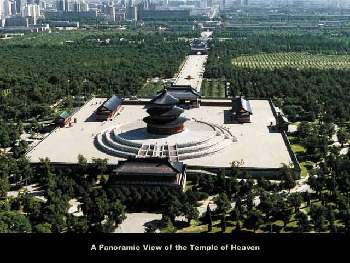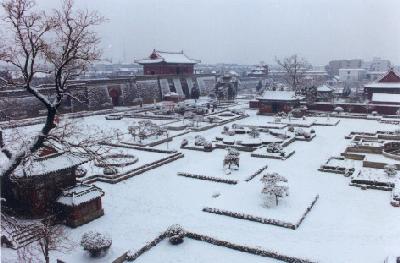As early as the prehistoric age, there had been worship of natural gods and ancestors, which thus developed into a primitive religion.Chinais an early-maturing society but this primitive worship was retained when it entered into a civilized society, and was carefully transformed by the Confucian school and thereby intensified. The imperial authority was set off by religious authority and clan power, which thus became an important spiritual pillar safeguarding the feudal hierarchy.
 Altar
Altar

The sacrificial methods of these two types of worship are often different. Generally speaking, ceremonies for worshipping the natural god, such as Heaven, Earth and the God of land and grain, were held mostly on a high terrace in the open, called an "altar", such as Tian Tan (TempleofHeaven), Di Tan (TempleofEarth), Ri Tan (TempleofSun) and Yue Tan (TempleofMoon). The four altars lie in the south, north, east and west ofBeijingrespectively. Tian Tan is in a plane round shape, and Di Tan square shape -- In ancientChina, this means Heaven is round and Earth is square.
 Temple
Temple

The worship of ancestors was done mostly in "temples", such as Tai Miao (ImperialAncestralTemple), Kong Miao (ConfucianTemple) and Guandi Miao. It was often called an ancestral hall, such as Sima Qian Ancestral Hall, Wuhou Ancestral Hall, as well as wise men's ancestral halls and clan halls.Templesfall into three categories: Tai Miao, or theImperialAncestralTemple, is the highest class ofTemple, with existing representativeBeijingTaiMiaoPalaceof the Ming and Qing dynasties (1368-1911).
Wise Men's Ancestral Hall is the place to worship some famous people in history. The most famous of this kind is Confucius temple, the largest of which is in Qufu, Confucius' (ancient Chinese philosopher and educator) hometown.GuandiTemple, also called Wu Miao inXiezhou,ShanxiProvince, worships the famous general Guan Yu in the Three Kingdoms Period (220-280).
Ancestor's Hall, or ancestral hall, is the place to worship clan ancestors, for instance, Zu Miao in Foshan, Guangdong Province. The construction and decoration styles similar to that of Zu Miao are very common in areas south of the Five Ridges,Guangdong,FujianandTaiwan.
 AltarTemple
AltarTemple

But some natural gods were more personified, and worshipping was often performed indoors, the site was also called a temple, such as Dai Miao, temple for worshipping the Mount Tai; and Zhongyue Miao, for worshipping Songshan Mountain. When put together they became "altar and temple", a type of architecture unique toChina. They were different from both religious temples and from palaces directly used for human existence. Altars in residences or gardens could be regarded as a para-religious building, while a temple, in most cases, has the meaning of a memorial hall.










